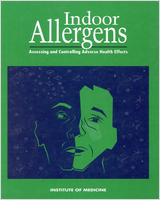NCBI Bookshelf. A service of the National Library of Medicine, National Institutes of Health.
Institute of Medicine (US) Committee on the Health Effects of Indoor Allergens; Pope AM, Patterson R, Burge H, editors. Indoor Allergens: Assessing and Controlling Adverse Health Effects. Washington (DC): National Academies Press (US); 1993.

Indoor Allergens: Assessing and Controlling Adverse Health Effects.
Show detailsThis report deals with the growing concern of many in this country about the indoor environment and its relationship to human health and comfort. Among the various health issues facing the citizens of the United States, the problem of indoor airborne allergens is one of the more serious. A high percentage of the population becomes sensitive to indoor allergens and suffers chronic or intermittent allergic disease. Most of these disease conditions can be classified as mild or moderate, but many are severe, and some are fatal. A perspective on this issue is provided by the estimated $6.2 billion annual cost of asthma-related illness in the United States. Although costs related to allergic asthma are by no means the largest component of this total, they are extensive enough to warrant attention to the role of indoor allergens in this condition.
Allergic reactions to indoor allergens can produce inflammatory diseases of the eyes, nose, throat, and bronchi, which are medical problems that come under the headings of allergic conjunctivitis, allergic rhinitis, allergic asthma, and hypersensitivity pneumonitis (extrinsic allergic alveolitis) respectively. The overall objective of our committee was to provide a comprehensive evaluation of current knowledge of these allergic diseases as they relate to airborne allergens in the indoor environments, and methods for their control.
The range of allergens to be found indoors is broad; it is set against the backdrop of an equally broad range of indoor environments. Our committee focused on airborne allergens, or aeroallergens, in residential, hospital, school, and office environments. We examined what is known about the adverse effects on human health caused by indoor allergens that elicit allergic reactions, characterizing the magnitude of these problems nationally and the populations that are commonly affected. We also identified specific causative agents and their sources and reviewed testing methodologies for indoor allergens, including their applicability and interpretation. Industrial environments were addressed only to the extent that a few specific industrial chemicals have been shown to be immunogenic and provide models for potential exposures in other environments. The report does not cover indoor allergens that are not airborne, such as contact allergens that elicit a lymphocyte-mediated contact dermatitis, for example, from dyes or cosmetics. Also not discussed are allergic reactions to therapeutic drugs.
A specific exclusion from the committee's scope of work was the phenomenon known as multiple chemical sensitivity (MCS). MCS was not addressed in any detail because the committee's focus was on the relationship between allergic agents and conditions mediated by the immune system. So far, scientific evidence that would support such a relationship with respect to MCS is lacking. As stated in a recent National Research Council report (NRC, 1992a, p. 138), "there is insufficient evidence to ascribe an immune etiology to this disorder." In addition, the sponsors of this project specifically excluded MCS from the charge to the committee.
As this report on indoor allergens evolved, the importance of the committee's multidisciplinary structure became apparent. Engineers, aerobiologists, epidemiologists, psychologists, and physicians subspecializing in allergy, pulmonary medicine, and immunology and epidemiology interacted and communicated with enlightening candor. The result was an educational process for all involved. The resulting coordinated effort attempts to provide a comprehensive, balanced report on a complex of health issues that appear to be assuming increasing importance. The recommendations generated by the committee stand as recommendations adopted by the committee as a whole. They are thus consensus opinions developed in the best interests of the public, the health care professions, the engineers and architects concerned with the structures in which we live, and the government agencies charged with carrying out the mandates of the people. The committee's recommendations are directed broadly, rather than toward any specific agencies, institutions, or offices, because the committee was not asked by the sponsors to address this aspect of the problem and did not believe that the additional focus was necessary or appropriate.
Finally, it should be noted that the conclusions and recommendations of this study are based on the knowledge and expertise available at this time. There remains a great need for research and further understanding of allergens and indoor environments. Notwithstanding such a need, it must also be emphasized that some aspects of the diseases discussed in this report cannot be altered even by major emphasis on control of indoor allergens.
For example, the rising death rate from asthma, a problem of international scope, extends beyond the issue of indoor allergens, because the severe inflammatory disease of the airways in many asthmatics often is not the result of allergen exposure. Control of severe asthma in patients with potentially fatal disease may involve addressing other problems, including psychiatric disease and socioeconomic factors such as poverty, the geographic distribution of medical care, and illicit drug use. To place too much emphasis on indoor allergens when other such major problems are present is not the intent of this report.
It is our hope and intention that this report will prove a spur to action. Many of the adverse health effects resulting from occupying indoor environments can be prevented. What is needed is a plan that embraces education of health professionals, engineers, building designers, and the general public—a plan that will not only improve the quality of life for millions of allergy sufferers but that will also result in substantial savings in many areas of the nation's health care costs.
Roy Patterson, M.D., Chair
Harriet Burge, Ph.D., Vice-Chair
Committee on the Health Effects of Indoor Allergens
- Preface - Indoor AllergensPreface - Indoor Allergens
Your browsing activity is empty.
Activity recording is turned off.
See more...